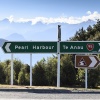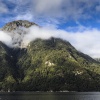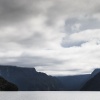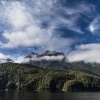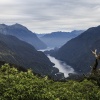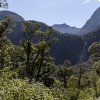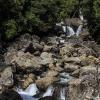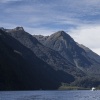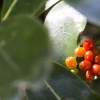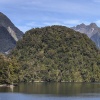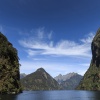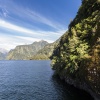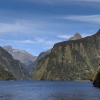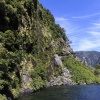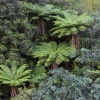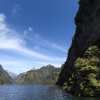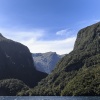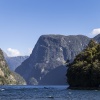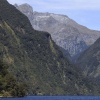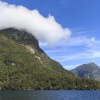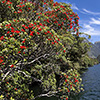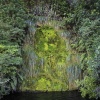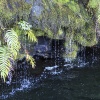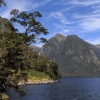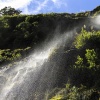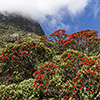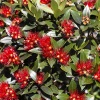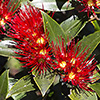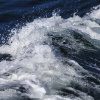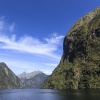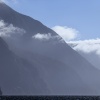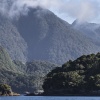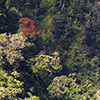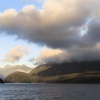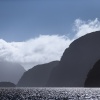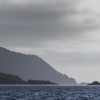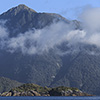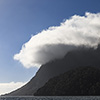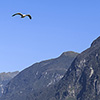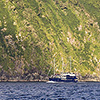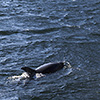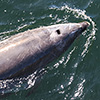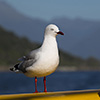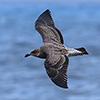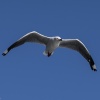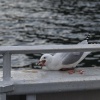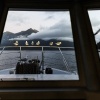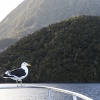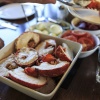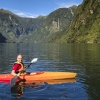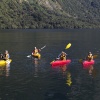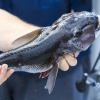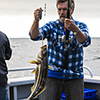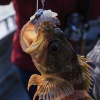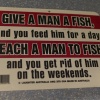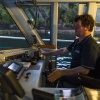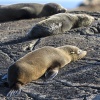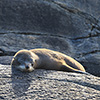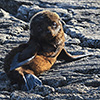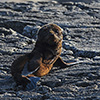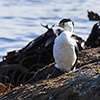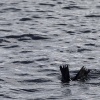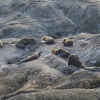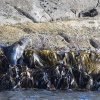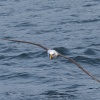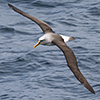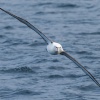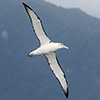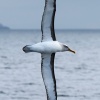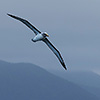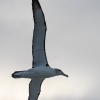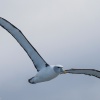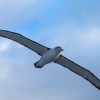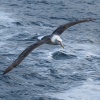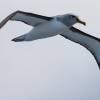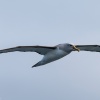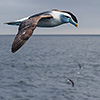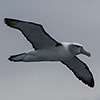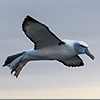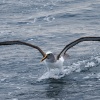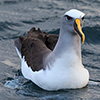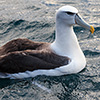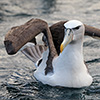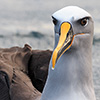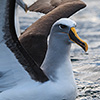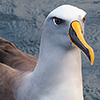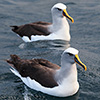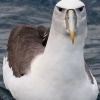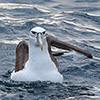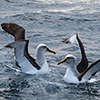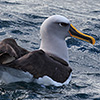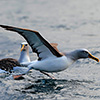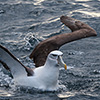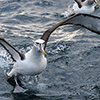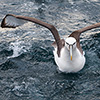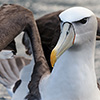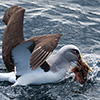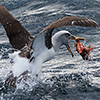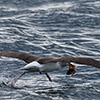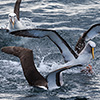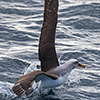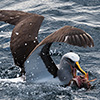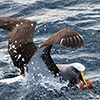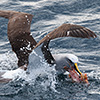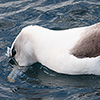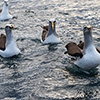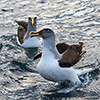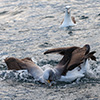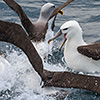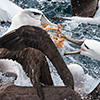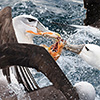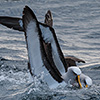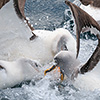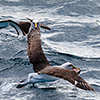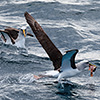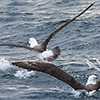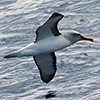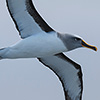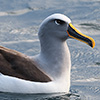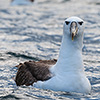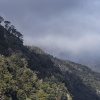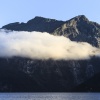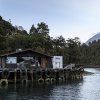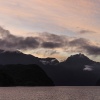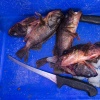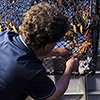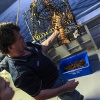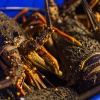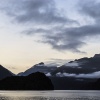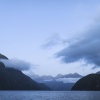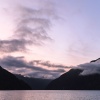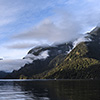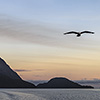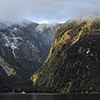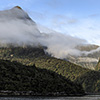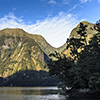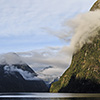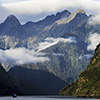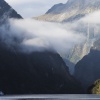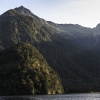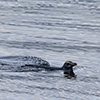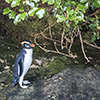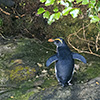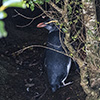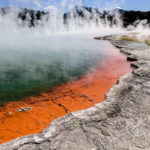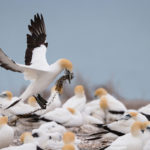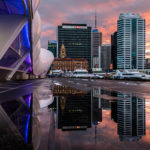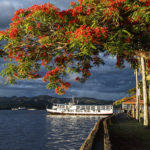Doubtful Sound – Where bold Cliffs meet bold Albatrosses
The Doubtful Sound at the south island’s west coast is one of the large impressive fjords New Zealand has on offer. Unlike Milford Sound, that is usually more known to visitors, it is more winding, has even a couple of islands and its steep slopes are entirely uninhabited unlike Norway’s fjords. Normally clouds hang low between its escarpments and it rains a lot but also for Doubtful Sound the summer of 2013 was a pretty dry one. The wild albatrosses living at the fjord’s estuary don’t care much about that as they have their own water supply. Meeting them close enough to touch and seeing them flying above the wave crests is the most august wildlife experience of southern New Zealand.
Actually this story begins at the Lake Te Anua, the entrance to Milford Sound, the fjord more known to visitors, but somehow I liked the scenery around Manapouri, at the Lake Manapouri and gate to Doubtful Sound, way much more and since accommodation prices were not that salty like in Te Anau I stayed at the banks of Lake Manapouri. The search for accommodation fortunately led me to Lake Side camping site where an over 80 years old lady runs the show. With a friendly “Hi fella!” she showed me around.
Fjord tours are in general not what I call reasonably priced in particular when it comes to staying there over night. Looking back I would have regretted to miss a wonderful experience and big adventure having driven a long way but not having done the final step, that is embarking on a fjord tour. Visitors can head off from both Milford as well as Doubtful Sound and of course some tours are individual while other tours are blunt mass processing. The old lady mentioned before got me in contact with Deep Cove Charters and put my fjord adventure into the hands of Captain Chris as well his son Travis, our cook.
The journey starts with a ferry transfer over Lake Manapouri. Its setting, high and craggy mountains is already quite an eye catcher. Both lakes, Manapouri as well as Te Anau (being New Zealand’s second largest lake when it comes to volume) lost a lot of water. The banks of both lakes are pretty much naked and should be not stony, actually covered with water. New Zealand’s newspapers are thin and three sheep pinching their hoofs are already worth a report. However, today’s title page says that Lake Te Anau lost as much water as never before. Kiwis will remember summer 2013 for a long time.
The blazing summer sun also has an effect on the fjords lands. Of course for us tourists it is great to have marvellous weather as even a swim among the cliffs is possible, but for the countless waterfalls Doubtful Sound is actually known for the heat is quite toxic. Also in terms of clouds things are pretty much mixed up as usually they hang low between the fjord cliffs creating pure mysticism, but these days the sun roasts them away completely within the early midmorning hours already.
Having barely disembarked the ferry sandflies immediately start to attack the bipedal human boatload. Jesus, how I hate them…! Fortunately Chris quickly gets the minibus and we head off to the yacht landing place without much ado. The small road between ferry port and the actual start of the Doubtful Sound fjord is one of New Zealand’s roads being built with very high efforts as it needed to be cut into the bare rocks. At its end an iron-made yacht and ocean-going “monster” waits for us that Chris and Travis put out to sea within the blink of an eye.
We deeply invade into the Doubtful Sound as well as its arms and to almost every place Chris knows an anecdote. His knowledge of the fjord seems to be a mine of information as it is full of interesting stories, for example about earth quakes happening over there. Yes, Earth pretty much shakes even down in the south of New Zealand and even with remarkable magnitudes up to 7. Chris personally knows all the scars being left behind my the recent big quake and introduces them to us while we have lunch, that is having crayfish as much as till the cow comes home.
“Anyone fancying a kayak ride?”, asks Chris around and gets an instant enthusiastic “Hell yeah!” from my side already before having finished speaking. Sitting in a kayak the fjord becomes truly magic as Chris stops the noisy engines. Far and wide there is nothing but the sound of water drops dripping from my paddle back into the pristine sea; a wonderful experience that, if things were only up to me, should never have an end. To boot the water is most inviting to have a swim. It’s huge fun to jump from the boat, swim among steep mountains and just put one’s feet up, not literally of course but in the meaning of pure relaxation.
With dolphins surfing on our bow wave the journey continues as chris desperately wants to show us the ford’s estuary, where the Doubtful Sound meets the Tasman Sea. The small islands offshore are home to a colony of sea bears and sea lions. Except the ever curious offspring all other animals ignore us pretty much. Lazy they lie in the sun while the sea lion baby watches our boat passing by. It has to be careful as seals are the number one on the menu if the big sharks. Despite the wonderful water here, at the fjord’s estuary, it is not recommended anymore to take a swim.
Where the fjord meets the ocean sea conditions are considerably rougher and the yacht literally rolls through the waves. Suddenly the first flying artists appear at the horizon. Albatrosses! Like being set on fire I run to my cabin and get the long lens photo stuff. In the meantime the bird, a white-capped albatross, came closer and now circles around us. Its wingspan is 2.50 metres which is already impressive when seen from far away. More and more birds approach us. Taking proper photos of them is quite a lottery though as the animals are very quick and the waves constantly add a very random moment to my shooting…
With a winking “now we should get something for dinner” Chris thrusts fishing rods into the hands of my fellow travellers. I prefer to catch albatrosses, photographically of course. Bird after bird appears out of the blue, now even other species, even rare species like difficult to distinguish Buller’s, Chatham or Grey-headed Albatross.
First species was named after its discoverer, the NZ-based ornithologist Walter Lawry Buller while the second albatross type looks very stern and serious due to a dark triangle around its eyes and their facial expression reminds a bit of the evil eye look of a tuned car. Like Buller’s and white-capped albatross also the Chethams are threatened.
Meeting them and watching them flying is just wonderfully beautiful. The sea belongs to them, not to us humans. Those magnificent birds MUST love flying, otherwise I would have no explanation for their gorgeous way of taking to the skies and sailing through the crests of the Tasman Sea. If I would be an albatross I would fly the same way, like a Red Baron and free free free to go everywhere. What they love is to take advantage of the oncoming wind while approaching the yacht. They fly straight into it, sometimes even together as team and then cast themselves to the wind. For a moment they literally stand in the air and you can see their whole wingspan before the gusts take them further. Albatrosses have special wings as they can latch their wing joints. This way they can sail with most minimal effort through the sky of the southern oceans.
My fellow travellers catch fish after fish, even pretty big ones. Chris fillets them literally within the blink of an eye. It’s sheer unbelievable how quick that guy handles the knife. The birds are pretty keen on the fish bones and the skin. Mouth-watering fast food for albatrosses to say so and meanwhile there’s at least a dozen of birds around the boat waiting to get a quick bite. Awesome, I can even feed them!
Once the food is in the water the cackling and also competition starts to catch it. A fantastic and very touching moment. Normally I don’t feed wild animals but since there is lots of rubbish and plastics in the sea, for example rests of old weathered fishing nets looking like squid, they get something decent to eat, real food from me.
Some albatross species spent up to 60-70% of their life and even a couple of years at one time on the high seas of the southern oceans. The obligatory water drop on their beak always makes them look as if they caught cold, but it is concentrated brine. Albatrosses are highly adapted animals and they can drink from the ocean as behind their brain they have a special organ to process saltwater. The final product of that process, brine, then gets exuded through the nostrils again. Having met such wonderfully free birds, flying artists and highly adapted animals was by far the most touching experience I had in New Zealand.
Unfortunately it was already time to say Goodbye to the kings of the sky. Meanwhile the sun is about to set and illuminates the clouds embracing the fjord’s estuary. Chris departs and quickly finds a place for us to stay overnight but before anchoring we drive around a little to clear a couple of crayfish traps. Some of those crustaceans are big blokes. “Yuck!” says Chris suddenly as he spots an eel. “Those snotty eels produce a repulsive slime when feel trapped.” Winking he adds, “well, the Japanese cook soup out of that…” – what a wonderful verbal introduction of the following dinner ;-)
Cook Travis presents a well-laid table with super fresh fish, steamed, and unbelievably good roast venison plus veggies. Culinary spoiled in such a manner I sit on deck and watch the sunset. There’s a celestial peace in the whole fjord. A couple of clouds travel through the sky but no potential rain. At some point my eyes sink and it’s time to see my cabin. The sunrise on the next day is not less beautiful, in particular due to the mirror-like water surface. There’s no wave around until we start the engines again to reach the little yacht pier at the fjord end again. Wrench is on our souls as we have to say Goodbye to a very beautiful and impressive place on this planet.
On the way back to the yacht pier Chris suddenly spots a small head peeping out of the water. A couple of Fiordland Crested penguins, the Maori call them Tawakis, is on the hunt for breakfast. Carefully he moves the big boat towards the animals. Fortunately they are not pretty much impressed of us and keep going their hunting. Though they leave the water and go ashore on one of the small island and disappear in the thicket.
That was our last wildlife encounter at the Doubtful Sound as only two hours later we are already on the ferry bringing us back to Manapouri, where we go our own ways again, but with a wonderful impression in our heart and memory; we can look back on a great adventure. New Zealand is not cheap, also the fjord tour wasn’t but it was worth every single cent spent, from accommodation and food to getting exceptional impressions of New Zealand’s nature. Thanks and greetings to Chris, Travis and of course Diane from Deep Cove Charters.

